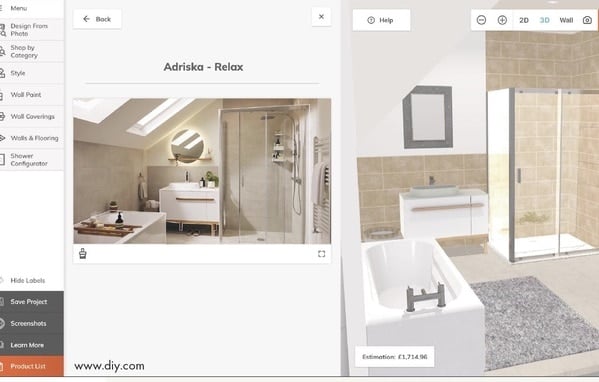In a series exploring 3D visualisation, Digital Editor, Scarlette Isaac, looks at how UK retailer, Kingfisher is enhancing the online customer experience with 3D design technology to bring products to life.
Kingfisher is using visualiser technology from Marxent to assist customers in buying kitchens and bathrooms in store banners such as B&Q and Brico Depot Romania, as well as to view flooring and wall options for other rooms.Such solutions are seen as part of the company’s wider online offering, says Kirsten Groves, head of digital experience at Kingfisher.
“We are building solutions that are truly omnichannel,” she says. “We want customers to be able to start and buy their projects online, but we also recognise the need for support from a colleague as part of that experience. It is therefore extremely important to build seamless solutions to allow customers and colleagues to be able to collaborate whether at home or instore.” The pandemic’s impact on consumer’s attitude to buying in general online has led to greater acceptance of such services, she notes. Online is certainly growing fast, with 18% of Kingfisher’s sales made online in its 2020/21 financial year and overall ecommerce sales rising by 158% during the same period.
In January 2021, B&Q launched a virtual sales model for its kitchens and bathrooms with the retail group reporting “several thousands of virtual showroom planning sessions” since its launch. These online appointments allow customers to book an initial design appointment with a design consultant and, as well as to link to the company’s 3D kitchen visualiser and virtual showroom. In the first appointment, a 3D design is created by the advisor that’s ready to share with the customer at the second design meeting.
“Customers have become more comfortable about starting their journeys online and have moved from a focus on inspiration to planning their projects,” says Groves. “What is key in this space is making it easy for customers, so we introduced virtual appointments during Covid. They are extremely successful as they can be held outside of store hours and can be initially more convenient for the customer at the beginning of their journey. They are definitely here to stay.”
The retailer offers a range of visualisation solutions. “We have a visualiser that is a very quick way to see the different kitchen door ranges in predefined room shapes,” says Marcus Muktarsingh, group head of proposition, kitchens, at Kingfisher.
Currently, customers at B&Q can use this to quickly try out room configurations such as changing flooring, cupboard doors and work surfaces. The room visualiser is also being trialled for living rooms and hallways at B&Q, allowing customers to change the wall paint and flooring of the desired rooms too.
The playful, gamification aspect Besecker mentioned earlier is a powerful driver of sales. “We see this as a lead generator for the more detailed room planning solution and to get a customer to make a virtual or in store planning appointment,” says Muktarsingh.
The company’s range of room planning solutions allows the customer to make more detailed plans and decisions within their own space. “This provides the best solution to bringing a customer’s dream to life, ensuring they have functionality to suit their life stage needs and design to suit their tastes,” he says, adding that the ability for customers to share designs is also crucial. “This is where customers will need more support and will want to share designs with friends and family, so being able to save, access designs and collaborate is key.”
Such a range of solutions helps customers think beyond the functionality of the product to the bigger room look, making them think about adding additional products they might not have previously considered, as well as to think about wider design elements. The success of the technology will see such tools used further with the company looking to enhance the mobile panning experience, the use of VR and taking advantage of Marxent and its Pinterest partnership. “We are also looking at how we can use and extend the same technology to help customers configure smaller product purchases, such as a piece of bedroom furniture or other ‘rooms’ like outdoor spaces,” says Groves.
This case study was originally published in our white paper written in collaboration with Marxent.
To learn more about bringing products to life using 3D technology, download the full report here.






